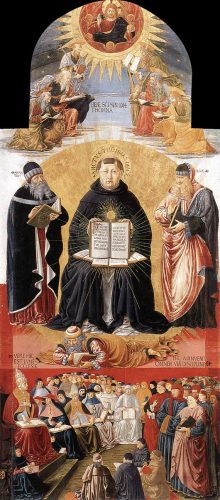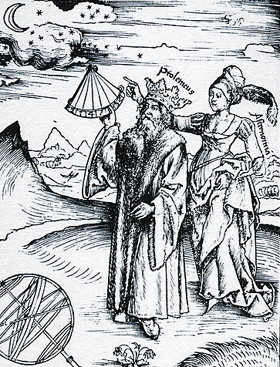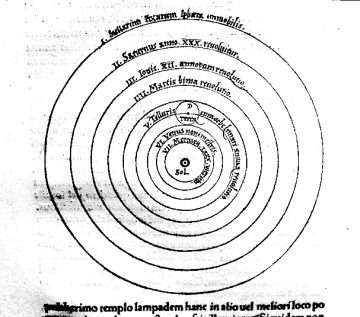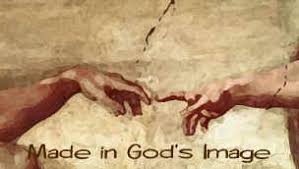I.

(wikipedai.org/public domain)
The ancient Greeks – Plato and Aristotle, especially – made a distinction between two approaches to science. (And, by science, they meant anything that could be known by reason): The method of the astronomer and that of the physicist. (Don’t be misled by these terms, for these ‘methods’ apply to any science, not just astronomy. It just happens that astronomy, sometimes called cosmology – the study of the heavens – was the primary ‘science’ of the ancient world).
The purpose of these two methods was to predict, and to some extent explain, the motion of the planets – whose Greek name means ‘wanderers’ – including the Sun and the Moon, as they traced their oft erratic orbits around the Earth. The astronomer, also called a ‘mathematician’, since the method involved much geometry – attempts to provide a ‘model’ of this erratic motion, which should do two things: First, to trace out and predict their paths, which would help with such necessary things as timekeeping, setting the monthly and yearly calendars, and for navigation. Second, and more controversially, the model should also, as Plato puts it, ‘save the phenomena’, the ‘phenomena’ being what appeared to our senses, from our perspective here on Earth. By ‘save’, the model is meant also preserve the a priori physical assumptions which the astronomer holds as inviolably true.
These assumptions, or principles, may be derived from various sources: theology and religion; or from some other source of authority; or from what seems ‘obvious’ and ‘common sense’; or, to use modern jargon, what is held by consensus. The ancient Greeks held as true, even sacred, the following physical principles:
- That the Earth was immobile and at the centre of the cosmos. This very much seemed to be the case, from the evidence of our senses (and it is still very difficult to prove the Earth moves while standing on the planet). Also, the centre was the only fitting pace for the abode of the gods and men.
- That all the planets – including the Sun and Moon – moved around this stationary Earth on perfect circles and at a uniform speed (which, again, is only fitting the perfection of the celestial orbs – how dare they move on imperfect ellipses or at erratic speed!)
- That all the stars and planets were made of ‘quintessence’ (‘fifth’ essence) which, unlike Empedocles’ terrestrial four elements of earth, air, fire and water, was unchanging, perfect and eternal.
With a few exceptions (Pythagoras, Aristarchus), these principles were held by the Greeks to be physically true, (not least with the influence of the great Aristotle) in accord with how the cosmos must be in accordance with its nature (physis being the Greek words for ‘nature’). A scientific model was held to ‘work’ when it successfully ‘saved all the phenomena’ within the confines of these assumptions.
Here is Simplicius, a sixth century Neo-Platonist (+560), summing this up for us:
Plato lays down the principle that the heavenly bodies’ motion is circular, uniform and constantly regular. Thereupon he sets the mathematicians (that is, the astronomers) the following problem: What circular motions, uniform and perfectly regular, are to be admitted as hypotheses, so that it might be possible to save the appearances presented by the planets?
II.
Yet, science cannot stop there, for to complement the model-building method of the astronomer, we must add the method of the physicist, whose task is to seek the actual nature of the cosmos, the ‘reality’ behind the model. The physicist’s task is also two-fold: To provide the a priori principles that guide the elaboration of our models, as for the Greeks and their perfect circles and stationary earth.
Yet the physicist also – or should also – gather evidence to test the model as time goes on, and experience builds up, through our senses and empirical verification (whether or not assisted by technology, such as telescopes and microscopes and such). Are the assumed a priori principles actually true? Does the model hold up against the evidence? How far can we adapt a given model to ‘save the phenomena’ of our dearly held beliefs, before it just breaks down, and must be declared, alas, false?
III.
Aristotle, Plato’s erstwhile student and colleague, posited that the planets rotated around the Earth in concentric, crystalline spheres. The problem is that the planets don’t appear to move in perfect circles, nor at uniform, regular motion, from our vantage point. (That is, the phenomena escape the model, and must therefore be ‘saved’). Rather, they speed up, slow down, even move backwards – so Aristotle had to add more and more spheres, eventually up to 57 of them, to account for these phenomena, that is, to maintain the hypotheses of ‘circular, uniform and constantly regular’ motion.
A half-millennium later, the great astronomer Claudius Ptolemaeus, ‘Ptolemy’ (fl., 150 A.D.) wrote the most influential – not the most true, mind you – astronomical treatise of all antiquity, the Syntaxis or Almagest. By this time, much more data – phenomena – from the planetary motions piled in, and their motions (again, from what we could perceive) was horrendously complex. Ptolemy hence strove to ‘save’ the a priori principles – the centrality and immobility of the Earth, the uniform motion, the circular orbits – with ever-more mathematical ‘tricks’. He added eccentrics (centres of orbits that were not at the actual centre, to account for apparent changes in distance); epicycles (orbits on top of orbits, to account for changes in speed and retrograde motion); as well as equants (points around which the planets moved in uniform angular velocity, sacrificing uniform linear motion, to account for irregularities in the shapes of the orbits).

Ptolemy’s model was generally held still to be physically true – despite its cumbersome mathematical complexity. Others did not care much whether it was true or not, just so long as it ‘worked’, and could predict the heavenly motions (which it did, reasonably well).
Ptolemy’s geocentric model was not formally challenged until Nicholas Copernicus in 1543 posited his famous heliocentric model, placing the Sun at the centre of the cosmos, and the Earth whirling around it at great speed, while spinning on its axis. This seemed unbelievable to many, but Galileo would champion Copernicus’ model, with great controversy.

The problem was that no one could test any of these models, to prove by physical evidence which of them was true (not even the mighty Galileo had such, which was in large part what got him into trouble). They could not go ‘outside’ the system to see the Earth and planets moving, but had to trust their senses, which were limited, conflicting and open to interpretation. What happens when more than one model might ‘save the phenomena’? How does one tell whether one is more true – more in accord with nature – than another?
One way, still very influential in science, is the ‘razor’ attributed to the 14th century Franciscan William of Ockham (but which, like many things, goes back to Plato): That the truest model is the simplest one. Natura amat simplicitatem, wrote Newton in his Principia, nature loves simplicity, and, he added with flourish, suffers not the pomp of superfluous causes. We will return to this in a moment.
Another, perhaps more convincing, sign of the truth of a model was the physical evidence that could be gathered for or against it. For the astronomer should also seek to correct, adapt, even discard, the model, as new evidence from nature comes to light. How the planets really move, and where the Sun and the Earth really were, was a controversy, prompted by Galileo, that helped build the methodology of modern science. Modern physics may now tell us that our planet is spinning at about 1000 miles per hour (at the equator) and whizzing around the Sun at a mind-boggling 67,000 mph, but few of us could prove that from where we’re standing.
We now also know that the other a priori principles of the Greeks are all wrong, or at least not fully right. Copernicus and Galileo got closer to the truth by placing the Sun at the centre, but, mesmerized by their master Pythagoras, who held all reality to be number and mathematics, they could not let go of perfectly circular orbits and uniform motion. (And, anyway, Einstein with his theory of relativity would claim that the ‘centre’ of any system depends upon one’s frame of reference). Kepler got even closer to the physical truth with his elliptical orbits (although most planets move on almost perfectly circular orbits, they are not quite so), and his three laws of planetary motion are still held dear by NASA. But even Kepler requires further refinement, for the planets all influence each other, and there are precessions, wobbles and weaves. Reality – physics – is infinitely complex.
That is why, as Pope Saint John Paul II was to state quite righty in his 1996 commentary on the Galileo affair to the Pontifical Academy for Science, that this complexity of our cosmos “indicates precisely that, in order to account for the rich variety of reality, we must have recourse to a number of different models.”
In other words, no univocal model can possibly account for all the phenomena, and we will always need multiple models to account for reality – but we can access that reality. There are those – inheritors of Auguste Comte – the logical positivists, who hold that all we can know are ‘models’, and that the true nature of things is always beyond our grasp. In fictional terms, this is the realm of the ‘matrix’ – all we know are our own thoughts, a universal solipsism, which slips quietly into a solitary madness, as did Comte himself.
Not so, for Catholics hold firmly to a realist metaphysics, that we can know not only God’s nature, but even something of God Himself through His nature. The more we peer into His works, as our microscopes see ever-smaller, our telescopes ever-farther, with ever-new phenomena, the more our models are tested against the ordered and enduring cosmos that God made, we will have to refine, reform and even at times reject our models, along with the a priori principles on which they are predicated and built. Truth is an adequatio rei et intellectus – a conformity between the mind and reality, and that conformity is an ongoing adventure.
IV.
 To apply this to a sort of current example, in light of Our Lady of Fatima and her ‘Miracle of the Sun’. When those thousands of spectators, huddled in the rain on that October 13th, 1917, saw the Sun dancing, careening, spinning in the sky, beaming out multi-coloured rays of light, hurtling towards the Earth and back, some screamed, others prayed, while still others ran for the caves. They all interpreted these phenomena – the method of the physicist – according to their a priori principles. For some, it was definitely a miracle of divine origin; for others, an atmospheric disturbance; still others, mass psychosis; and I just heard a short documentary that claimed it was aliens warning us.
To apply this to a sort of current example, in light of Our Lady of Fatima and her ‘Miracle of the Sun’. When those thousands of spectators, huddled in the rain on that October 13th, 1917, saw the Sun dancing, careening, spinning in the sky, beaming out multi-coloured rays of light, hurtling towards the Earth and back, some screamed, others prayed, while still others ran for the caves. They all interpreted these phenomena – the method of the physicist – according to their a priori principles. For some, it was definitely a miracle of divine origin; for others, an atmospheric disturbance; still others, mass psychosis; and I just heard a short documentary that claimed it was aliens warning us.
We could apply this to any phenomena we like: Was Adam a Cro-Magnon man? When did he live? Is the Earth getting warmer, or colder, and what is causing this? Is the universe 13.5 billion years old, and is the ‘Big Bang’, true? What caused the extinction of the dinosaurs? And so on it goes, ad infinitum.
V.
We may extend this distinction beyond astronomy, or even science itself, all the way to our very modus vivendi itself – our way of living, our morals, based not just on our perspectives on not just on this life, but our belief (or disbelief) in eternity. When such a model encompasses our basic worldview, we might call in a religion, or one’s ‘system of values’, our metaphysical model. Islam has quite a different view of God and heaven than does Catholicism, and they both differ from the atheistic views of Hume, Huxley and Dawkins. Is sex binary, and did God create us ‘male and female’? Do humans have eternal souls? Do things go dark after death, as though we had never been born, or will we meet our Saviour and Creator? Is there an objective moral order, a natural law? Will we be judged on how we have lived in this life, the decisions we have made? Much depends on the answer we give to such questions, and a plethora of others, pondering which is much of what makes us human.
VI.
What has this to do with keeping peace and harmony, if at all possible? (I will provide a final note on that). For now, here are some conclusions and applications of what may seem an abstruse distinction between the ancient, and the new, astronomer and the physicist:
- The only ‘model’ we Catholics hold as inviolably and irrevocably true is that of our Faith, whose revealed truths we hold and profess by divine authority. Christ did indeed rise body and soul from the dead, and Our Lady was assumed the same into heaven. Hence, they will never find the ‘bones’ of either of them. The Eucharist is the true ‘substance’ of Christ. God is in His heaven, and we all have angels guardian. We will not prove these by phenomena (barring the exceptional miracle), but we hold them nonetheless, because God revealed them through His infallible Church.
- About all our other models, scientific and otherwise, we should have some level of healthy doubt, even if a smidgen, and we should not be too wedded to our scientific and hypothetical models, but be open to new evidence and phenomena as they arrive. We should have open minds (but not so open that everything falls out, as Chesterton warned). That gravity exists is beyond doubt, but why and how it does so depends on one’s model of cosmology (the current Einsteinian four-dimensional curved-space theory being the current predominant one, and likely physically true).
- A helpful distinction here is between what Cardinal Newman called certainty – the objective truth of our arguments, our models, our worldviews – and certitude, the degree of confidence with which we hold them. We should keep these firmly distinct – believing something to be true does not make it so, and the same holds for what we might hold to be false. Evidentiary truth eventually wins the day. David Hume died a stubbornly professed atheist, but he was no longer one when he crossed that veil, and beheld the Son of God, whose existence he had denied.
- We must avoid vague generalities and sentimentality, whether in science or morals – precision and clarity are essential in whatever ‘models’ we hold, and what they imply. What does ‘evolution’ really mean? Darwin did not know of genes, DNA, alleles and such, and to get down to the molecular basis of the diversity of species is a complicated and controversial business. ‘The devil is in the details’, but more properly, the truth is often found therein.
- We should be free to pick or choose only some aspects or principles of any given model. Galileo could have adopted Copernicus’ heliocentrism, without his perfect circles (but, remember, he was hypnotized by Pythagorean mathematical perfection). We also may accept aspects of Darwinian evolution – species adapting to their environments – without the entire enchilada of his agnostic, blind-nature-working-by-random-chance.
- Beware of models that extend beyond phenomena we can now perceive, and predict into the future – for if present phenomena are complex enough, the future phenomena are exponentially more so. This is what many scientists often mean by computer ‘modeling’, and many of the claims made on such – from population growth, to resources, to climate change – have already fallen far more into the realm of fiction than science.
- And, to return to John Paul II on a final and perhaps most important note, we need many models to account for the rich complexity of reality. If the cosmos cannot be reduced to one, bland ‘univocal’ model, far less can the great mystery of Man made in God’s very image!
If possible, as our various models jostle for space, we might be considerate of others’ points of view. As the saying has it, in necesariis unitas, in dubiis libertas, in omnibus caritas – Unity in necessary things, freedom in doubtful things, and in all things, charity. So we might make true the prayer of the Psalmist: May peace reign in your walls, and in your palaces, peace.
The search for truth is a purifying fire, consuming the dross of falsity, and leaving the golden core. And only in that truth will we ever have lasting, indeed eternal, peace and freedom.
You can take that as physically true, on divine authority.











